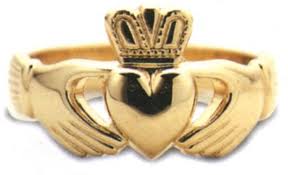
February and Romance - The Claddagh Ring
https://www.facebook.com/thelighthousestringband/
By Mary Maguire
Once January 1st turns, the store shelves become ablaze in a color of reds and pinks, enormous amounts of glitter, and shapes of hearts and cupids. Of course, we must not forget the chocolates, the very extravagant bouquets of flowers, and last but not least, the jewelry.
In Ireland, romance & jewelry has been truly alive and well for centuries. The CLADDAGH RING, for instance, has been around since the 17th century. The history of this ring alone provides a glimpse into the past life of courtship and love.

The Claddagh ring has been, (and is sometimes still considered to be) the traditional wedding ring of the Irish since the 17th century. Today, the Royal Claddagh ring is worn by people all over the world as a universal symbol of love, loyalty, friendship and fidelity, and of course, Irish heritage.
Worn on the right hand, with crown and heart facing out, the ring tells that the wearer’s heart is yet to be won. After falling under love’s spell, however, it is worn with heart and crown facing inwards. When worn on the left hand (always with the crown and heart facing inwards), the ring signifies that love has been requited.
The Claddagh was first fashioned into the traditional ring back in the 17th Century during the reign of Mary II; it was originally a symbol of the “Fisher Kings” of the Galway town of Claddagh, Ireland. Legend has it that a young Irish man named Richard Joyce, who was bound for the West Indian slave plantations, was kidnapped in rough seas by a band of Mediterranean pirates, and subsequently sold to a Moorish Goldsmith. It was during the many long years of Joyce’s exile that the Goldsmith taught him the skills of a master craftsman, and where Joyce created the first gold Royal Claddagh ring. When King William III negotiated the return of the slaves in 1698, Joyce returned to Galway – despite, it said, the Moor’s offer of the daughter’s hand in marriage and a princely dowry of half of all his wealth.
Meanwhile, back in Ireland, a young woman had never stopped the faithful waiting for her true love to return. Upon his return he presented her with the now famous Royal Claddagh gold ring – a symbol of their enduring love. They soon married, never to be separated again.
With this crown – I give my loyalty
With these hands – I offer my friendship
With this heart – I give you mine
In love, in friendship, let us reign.
Traditionally handed down from mother to daughter, the Royal Claddagh ring has also become a symbol of our ties with the past and generations gone by. As Irish people, we remember the many people who had to leave Ireland with nothing during the Great Famine of the 19th Century – many leaving Cork Harbor to make the long voyage across the Atlantic to America. For many, the gold Claddagh ring was to become the only enduring link with their home country, and their only family inheritance.